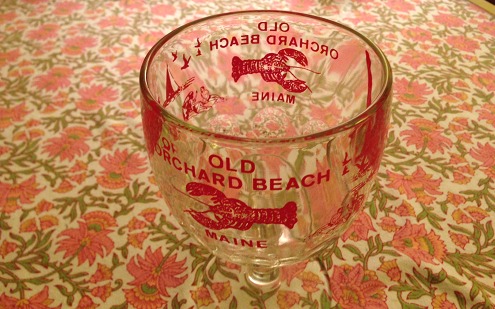
One of the sillier things I have seen pass across the internets lately came up as part of the anti-shaker campaign. You will recall that the function of that campaign is to convince you, the beer buyer, that an 8 oz serving of beer for “X” bucks is better than a 16 oz serving for “X” bucks by insinuating that you are not capable of sensing taste and smell in a drinking vessel without acute curves and a thin stem. Silly. But expensive. They hope you are are that sort of sucker. The silliest thing I have heard as part of this campaign is that shaker glasses are “old fashioned” – that they are a lingering legacy of the age of big macro, the age of industrialized adjunct corn lagers. Add your doom-laced adjectives to taste.
Like so many things that depress one about discussions of beery things, it’s not correct. I knew as much from my months of perusing newspaper and magazine ad images for the writing of the beer histories. But how to prove it to you? Ah, Jay Brooks to the rescue. See, Jay has been posting many things for a mighty long time over at his beer blog and one of the best is an accumulated archive of beer advertising from the golden age of pre-craft. As of the date of this post, Jay is up to ad #1354. If you scan through the ads you will not see any glassware that looks like a shaker. Or at least not many. You will see lots of tall narrow “pilsner” glasses. You will see squarish tumblers. And you will see goblets.
 I love the goblet. I love this one in particular bought, as you might guess, in Maine. It has images of sailboats and lobsters and diving girls. Click on the image for the full fine detail. It has hefty dimples at the bottle of the bowl that help it fit the hand. It is thick and heavy and holds a full serving. It is ever so slightly tapered in at the top. It is built for a richly carbonated corn based lager circa 1966. And it does the job just fine. A pal whose friendship I deeply value was jealous when I spotted it at the second hand store before he did. He was right to feel that way.
I love the goblet. I love this one in particular bought, as you might guess, in Maine. It has images of sailboats and lobsters and diving girls. Click on the image for the full fine detail. It has hefty dimples at the bottle of the bowl that help it fit the hand. It is thick and heavy and holds a full serving. It is ever so slightly tapered in at the top. It is built for a richly carbonated corn based lager circa 1966. And it does the job just fine. A pal whose friendship I deeply value was jealous when I spotted it at the second hand store before he did. He was right to feel that way.
As I pointed out a couple of weeks ago, if you want to smell your beer, get your nose in there. One of the most irritating things about the snifter is how it (i) does not allow snifting until it is half empty thus lying to you for the first half of the drink and (ii) you often cannot get your nose in their so it lies to you for the second half. The goblet and the shaker and the nonic do not lie. You can be immersed in the full aromas if you wish to engage with the glassware. You can choose not to and avoid looking like the guy who relies on sandwich tongs when reaching for a hot dog.
Household hint. If you really want to open up the beer and add to your aroma experience, clean your glassware. Me, I use PBW powder when I am being a keener and wash a bunch of glasses before I am having a focused session. It’s the same stuff you ought to be using when you home brew. On everything. Everything the beer will touch should have this touch it first. That and Star San. Strip every bit of gunk off the glass and even the most basic good beer will have the best head ever, will give up all its scent potential, will tell you all it can.
Why is this not the main message promoted by folk telling you how to serve your beer? Well, there is no money in it for anyone. A supply of PBW and Star San might cost you about $12 a year. Any other reasons? Can’t think of any. It is, however, the best thing – and the cheapest thing – you can do for yourself and your beer.

